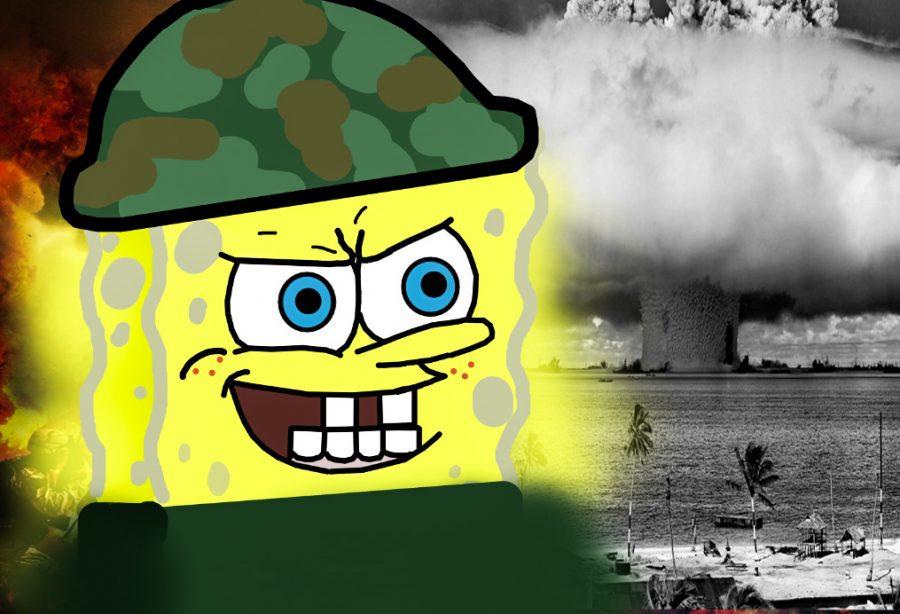OPINION: Viewers should pay attention to problematic themes in media
Recent UW paper studies pro-imperialist undertones in SpongeBob; has point
LAUREN PETTIT | DAILY EVERGREEN ILLUSTRATION
SpongeBob’s home of Bikini Bottom is set in the Bikini Atoll, a spot that the U.S. used for nuclear testing in the 1940s and 50s.
October 22, 2019
SpongeBob SquarePants’s beloved home of Bikini Bottom used to be a nuclear testing ground. Now one researcher believes that this show is a glaring example of U.S. culture glossing over injustices done to people of color.
Holly M. Barker, a principal lecturer in anthropology at the University of Washington, recently published an article in The Contemporary Pacific titled “Unsettling SpongeBob and the Legacies of Violence on Bikini Bottom”. While this idea may seem preposterous to some, Barker’s argument has a lot of credence.
In this article Barker argues that the entire show of SpongeBob is built upon institutional imperialism as well as racism, mainly due to how the United States used the Bikini Atoll for nuclear testing. These tests massively affected the local population and Barker argues that the show SpongeBob is a part of Americans not acknowledging the impact the U.S. has had on minority populations.
This is not a new phenomenon in television.
Jillian Lenicka, freshman nutrition exercise physiology major, said that she doesn’t really see overt racism in film and television, however earlier shows and cartoons definitely have those themes.
“Bugs Bunny cartoons were heavily into [racism],” history professor Ken Faunce said. “They had these ideas of barbaric people around the world that the United States was going to help.”
The most famous of these examples is the Looney Toons short “Tokio Jokio” from 1943, which by all interpretations today is incredibly racist. However, racism in media has changed drastically since the 1940s.
“As you move into the 90s and early 2000s they try to be more subtle about it,” Faunce said. “They dress a certain way, they have darker skin, they’re the bad guy.”
These themes may not be overt to many, yet it is important to understand that there are themes others can see that we do not. Especially when trying to understand the real place of the Bikini Atoll but seeing it in the lens of SpongeBob.
“Did SpongeBob’s creators intend to infuse a children’s show with racist, violent colonial practices?” Barker wrote in her article. “Perhaps not, but by taking place on Bikini Bottom, the cartoon becomes part of a broader, insidious practice of disappearing Indigenous communities and normalizing the nonsensical settling of a community where it does not belong.”
The U.S. took the Bikini Atoll away from its native people in the aftermath of World War II and almost immediately began moving these people away from their ancestral homes in order to conduct nuclear testing. This atoll was where the first hydrogen bomb was tested.
“When the first hydrogen bomb was tested, [the U.S.] screwed up,” Faunce said. “They moved the people, but they did not move them far enough.”
Not many know about the impact that U.S. nuclear testing had on groups of people around the world. When you think of Bikini Atoll, most don’t think about nuclear testing, but instead focus on the childhood show loved by many that spawns a new meme almost every other week.
Obviously Barker’s stance on the show is debatable.
“There is a lot to talk about in there, how much is substantiated, I’m not sure,” Faunce said.
However, it is important to think about the connotations that may not be seen right on the surface and understand that the creators of SpongeBob most likely did not intend to be a show that glosses over U.S. nuclear testing and displacement during the Cold War.
“It may not be an intentional thing,” Faunce said. “Some of this is institutionalized and some of it is intentional.”
You may not like it, but it is important to understand that pop culture and horrible things done by the U.S. often intersect. It is impossible to have something in a vacuum, and we need to understand that while we may not comprehend the impact a show may have on another group of people, seeking out other perspectives matters.





















